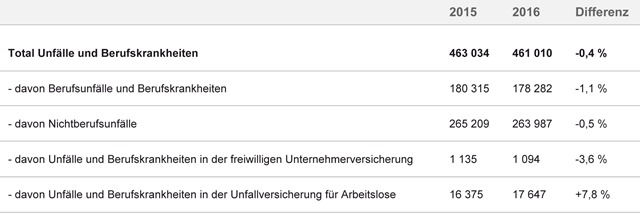Fewer and fewer occupational accidents
Once again, fewer occupational accidents and lower medical costs per case: This is shown by Suva's evaluation of the 2016 insurance year. Overall, the number of accidents also fell slightly last year.

In 2016, insured persons reported 461,000 accidents to Suva, as the company shows in its latest figures. The number of occupational and non-occupational accidents remained slightly below the previous year: The approximately 178,000 registered occupational accidents and occupational illnesses fell by 1.1 percent, while non-occupational accidents fell by 0.5 percent to just under 264,000. In accident insurance for the unemployed, the accident figures rose almost in parallel with the increase in job seekers. The figures were communicated via press release on February 15, 2017.

In occupational accident insurance, the number of accidents has fallen continuously by a total of 5.5 percent since 2011. This is despite the fact that the number of full-time employees has increased over this period. The occupational accident risk (number of accidents per 1,000 fulltime employees) has also been decreasing for years, the company adds. Suva attributes this decline on the one hand to its prevention work in the area of occupational safety. On the other hand, high-risk activities are generally decreasing as a result of ongoing structural change - for example, due to the increase in automated processes, it adds.
Overall, Suva can report a good result despite higher costs: The insurance company incurred daily allowance costs of CHF 1.35 billion in 2016, 3.5 percent more than in the previous year. However, the average duration of daily allowance payments remained stable at around 40 days. The higher daily allowance costs are partly due to the fact that more cases were settled in 2016 (+2.6 percent), namely a total of almost 231,000 cases. The reason for this, according to Suva, is that in 2015 they switched to new software for settling claims. This changeover led to backlogs of work that could be worked off last year. This is now reflected in the figures. Furthermore, the daily allowance costs were influenced by the general increase in average wages and the increase in the maximum insured earnings as of January 1, 2016, Suva added.
Source: Suva









